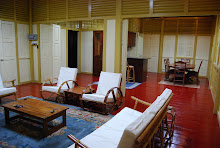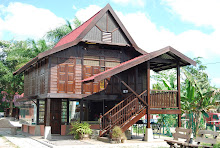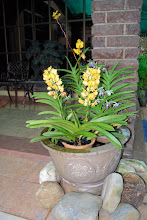Spot turfing, two 'cempa' trees planted in the compound, smoke from burnt dried leaves and the morning freshness conjure the kampong scenery . There were evenings when smoke help to disperse the mosquitoes and lent a scent not to be forgotten.
PERHAPS it is one of those refreshing morning, one dreams of. After a late breakfast of 'nasi lemak' wrapped in banana leaf, not one but two 'bungkus' together with hot cups of tea we found myself at our new kampong home waiting for the contractor and his men to come and start work on the landscaping of the area around the house. You could possibly upgrade the house compound in your own time and pleasure but it would be a haphazard and unplanned sort of way not knowing really how it would look like in its finality. But with people who know what they are doing, you would see their craftsmanship maturing in no time. Then again, many decades back we could possibly toil away throughout the day but exercise of such nature shy away for the moment.
A comment read recently said the you could take a Malay out of his kampong but not necessarily the 'KAMPONG' out of him. I would agree to such dictum knowing the sentimentality and nostalgia that the kampong atmosphere built within a person. Much as modernity, high rise buildings, furnished homes in the cities and all the sophistication geared towards making live better and happier, it could not take away the nostalgia and the old world charm of yester-years. Those who have at one time or another lived there would begged to return to such natural splendor. Thus the 'balik-kampong' syndrome and the annual rush every year during the eve of Aidilfitri or long weekends.
The roominess and the richness of wood plus the unique structure of the Malay home, where ceremonies one after another have taken place, games we played as children inside and outside the home, memories of mum and dad, grand dad and grand ma in their characteristic ways help to conjure times when we grew up in the old home. Alas many of us have lost that touch practically since many of the old homes have disappeared: replaced by modern brick buildings or the old place have been sold off or the family have moved away from their roots.
A comment read recently said the you could take a Malay out of his kampong but not necessarily the 'KAMPONG' out of him. I would agree to such dictum knowing the sentimentality and nostalgia that the kampong atmosphere built within a person. Much as modernity, high rise buildings, furnished homes in the cities and all the sophistication geared towards making live better and happier, it could not take away the nostalgia and the old world charm of yester-years. Those who have at one time or another lived there would begged to return to such natural splendor. Thus the 'balik-kampong' syndrome and the annual rush every year during the eve of Aidilfitri or long weekends.
No fence, no gate. Its openness and the mature fruits trees plus the bushes and tall trees with bird chirping away guarantee that the kampong home rebuilt will usher many more years of happiness for the family and the community around.
The games we used to play under the house! Never far from the caring eyes of the family. All kinds of games were indulged in. Bamboos from nearby bushes became shooters with paper bullets to scare the hoots of the gang members: 'Fighting" fishes were scouted, kept in glass jars, observed for their beauty and color and even combated for. It was healthy and safety as everyone was around the home. Alas it is not so now. Playing games would be away from home. 'Futsal' at special arena and never under the house with pillars as sentinels. Laughter , shrieks and all that bring identity and recognition to the 'kampong' scene have faded albeit disappeared now. Revived even temporarily it would be God sent.
How it brought back some semblance of the good years to see the grand children frolicking around the house and finding the heap of sand a hit with what they are discovering.
Here's hoping the brief conjures some flashbacks of times you were growing up in the kampong and hopefully the nostalgia can be retained where possible. It also sets on record that the old home that we set out to bring back to life is now completed.










































